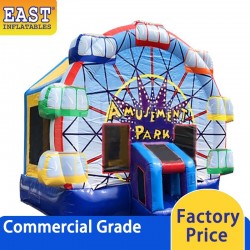
Securing inflatables, such as bouncy castles or inflatable slides, is crucial to ensure safety, especially in windy conditions. Proper anchoring and precautions can prevent accidents and keep your inflatable firmly in place. Here’s a guide on how to secure inflatables in wind.
1. Use Ground Anchors
Ground anchors are essential for securing inflatables. They help to firmly attach the inflatable to the ground, preventing it from being lifted by the wind. Here are some common types of ground anchors:
- Metal Stakes: Metal stakes, typically around 30 to 50 cm long, are driven into the ground through the anchor points on the inflatable. They are effective on grass or soil surfaces.
- Sandbags or Water Weights: If you’re setting up on a hard surface where stakes can’t be used, sandbags or water weights can be placed over the anchor points to add stability.
- Auger Stakes: These are corkscrew-shaped stakes that provide extra holding power, especially in softer ground conditions.
2. Monitor Wind Conditions
Always be aware of the wind conditions before and during the use of inflatables. Here’s what to consider:
- Wind Speed: Inflatables should not be used in wind speeds exceeding 20-25 km/h (12-15 mph). Most inflatables come with manufacturer guidelines on maximum wind speeds.
- Weather Apps: Use weather apps to monitor wind speeds in real-time and be prepared to deflate and secure the inflatable if wind speeds increase suddenly.
3. Utilize Guy Ropes and Tether Straps
Guy ropes or tether straps can provide additional stability to the inflatable:
- Attach to Secure Points: Guy ropes should be attached to secure points on the inflatable and then anchored to the ground with stakes or weights.
- Tension Adjustments: Ensure the ropes are tightly secured and adjust the tension as needed to keep the inflatable steady.
4. Regularly Inspect Anchors and Inflatable
Regular inspections are vital to ensure the safety of the inflatable:
- Check Anchors: Periodically check that all anchors are securely in place and haven’t loosened due to wind or ground conditions.
- Inspect the Inflatable: Look for any signs of wear or damage that could compromise the inflatable’s stability, such as tears or leaks.
5. Deflate in Strong Winds
If the wind speed exceeds safe levels, it’s crucial to deflate the inflatable immediately:
- Quick Deflation: Most inflatables are designed to be deflated quickly. Make sure the area is clear of people before starting the deflation process.
- Store Safely: Once deflated, fold and store the inflatable in a sheltered area to prevent it from being damaged by the wind.
6. Follow Manufacturer Guidelines
Always adhere to the manufacturer’s instructions regarding setup and safety:
- Read the Manual: The manual will provide specific guidance on anchoring, safe wind limits, and other safety precautions.
- Manufacturer Support: If you have questions or concerns, reach out to the manufacturer for advice on safely securing your inflatable.
Conclusion
Securing inflatables in windy conditions requires careful planning and the right equipment. By using proper anchors, monitoring wind conditions, and following safety guidelines, you can ensure that your inflatable remains secure and safe for use. Always prioritize safety and be prepared to take action if wind conditions become unfavorable.




Leave a Comment